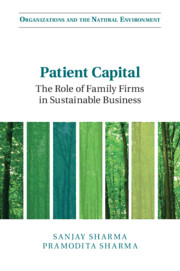Book contents
- Patient Capital
- Organizations and the Natural Environment
- Patient Capital
- Copyright page
- Contents
- Figures
- Tables
- Preface
- 1 Definitions
- 2 Primary Data: Cases from the Winery Industry in Canada, France, and Chile
- 3 Exogenous Drivers of Corporate Environmental Sustainability Strategy
- 4 Organizational Drivers of Corporate Environmental Sustainability Strategy
- 5 Managerial Drivers of Environmental Sustainability Strategy
- 6 Bringing the Family into the Corporate Environmental Sustainability Strategy: Implications for Research, Education, and Policy
- Index
- References
3 - Exogenous Drivers of Corporate Environmental Sustainability Strategy
Published online by Cambridge University Press: 12 July 2019
- Patient Capital
- Organizations and the Natural Environment
- Patient Capital
- Copyright page
- Contents
- Figures
- Tables
- Preface
- 1 Definitions
- 2 Primary Data: Cases from the Winery Industry in Canada, France, and Chile
- 3 Exogenous Drivers of Corporate Environmental Sustainability Strategy
- 4 Organizational Drivers of Corporate Environmental Sustainability Strategy
- 5 Managerial Drivers of Environmental Sustainability Strategy
- 6 Bringing the Family into the Corporate Environmental Sustainability Strategy: Implications for Research, Education, and Policy
- Index
- References
Summary
The two main exogenous drivers that have been examined in the environmental strategy literature are institutional and stakeholder influences. Drawing upon the institutional theory, organizations and natural environment and the family business literature the chapter develops insights into institutional influences and logics driving strategy in family firms. Drawing upon our primary data from the winery industry, it examines whether or not institutional forces will have a different influence on environmental sustainability strategies of family-owned firms as compared to non-family firms. Next, beginning with the foundational arguments of stakeholder theory including classification of stakeholders and their influences on a firms’ environmental strategy, the chapter argues that noticeably absent from the environmental sustainability strategy literature is a key stakeholder for family firms- the family. Based on this literature review and insights from our primary data, the chapter developd arguments about the influence of different stakeholders on family versus non-family firms, and how these influences are likely to impact the environmental sustainability strategy of these firms.
Keywords
- Type
- Chapter
- Information
- Patient CapitalThe Role of Family Firms in Sustainable Business, pp. 57 - 97Publisher: Cambridge University PressPrint publication year: 2019

